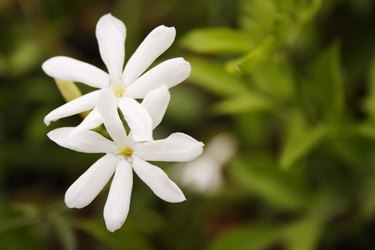
The enchanting flowers and fragrance of jasmine (Jasminum spp.) endear this group of plants to gardeners. With many varieties available, their hardiness spans U.S. Department of Agriculture plant hardiness zones 6 through 11. In Massachusetts, USDA zone 5 through 7, winter limits jasmine choices for outdoors. Depending on your location within the state, you may be able to overwinter jasmine outside. If not, you can enjoy jasmine indoors.
Wintry Wonders
Video of the Day
As the name suggests, winter jasmine (Jasminum nudiflorum) withstands cold temperatures. It also blooms in the midst of winter with yellow blossoms that shine through dreary days. It doesn't carry the fragrance most jasmines provide, but in the winter garden, you'll barely notice it's missing. Hardy in USDA zones 6 through 10, this jasmine reliably survives winter along the USDA zone 6 and 7 coastal areas of Massachusetts. With heavy winter protection and a sunny, south-facing exposure, gardens farther inland in USDA zone 5 may even successfully grow winter jasmine. Winter jasmine's canes can be tied to a trellis for a vine effect or allowed to maintain their willowy, shrub-like form.
Video of the Day
Poetic Interludes
Poet's jasmine (Jasminum officinale), also known as hardy or common jasmine, overwinters outside in USDA zones 7 through 10. In Massachusetts, it withstands winter temperatures on Cape Cod and the islands, and is marginally hardy in the urban heat island that pushes Boston into USDA zone 7. Along the USDA zone 6 coast, the plant can survive moderate winters and come back from the roots when planted in a sheltered, sunny area with plenty of protection. The only naturally vining jasmine suitable for parts of Massachusetts, poet's jasmine needs a cooling period to initiate and stimulate its intensely fragrant summer blooms. That combined with warm summer evenings produces a heavenly result.
Italian Tenderness
Like winter jasmine, Italian jasmine (Jasmine humile) offers delicate yellow flowers. Unlike winter jasmine, these blooms come in late spring and early summer and are followed by black berries. The flowers also bring fragrance, though not as strong as you may hope. Hardy in USDA zones 7 through 9, Italian jasmine benefits from additional winter protection and a sunny, sheltered location on the Cape and the islands. Even with protection, it will succumb to winter cold along the USDA zone 6 areas of the coast. Finely textured but shrub-like in form, Italian jasmine trains easily. For a vining effect, tie stems onto a support as you would a climbing rose.
Indoor Escapes
For gardeners inland in Massachusetts, in USDA zone 5, garden jasmines must be replaced each year. However, many jasmines excel as winter houseplants. Fragrant jasmines such as Arabian jasmine (Jasminum sambac), hardy in USDA zones 9 through 11, do beautifully when grown outside in containers for summer, then moved inside in fall. In Florida, they can be invasive. In Massachusetts, that point is moot. When temperatures drop to 50 degrees Fahrenheit, move the vine to your home's sunniest spot. Keep the soil slightly dry between waterings. You'll be treated to the vine's heady perfume all winter long. While you look out at winter jasmine in the garden, you'll be surrounded by fragrance inside.